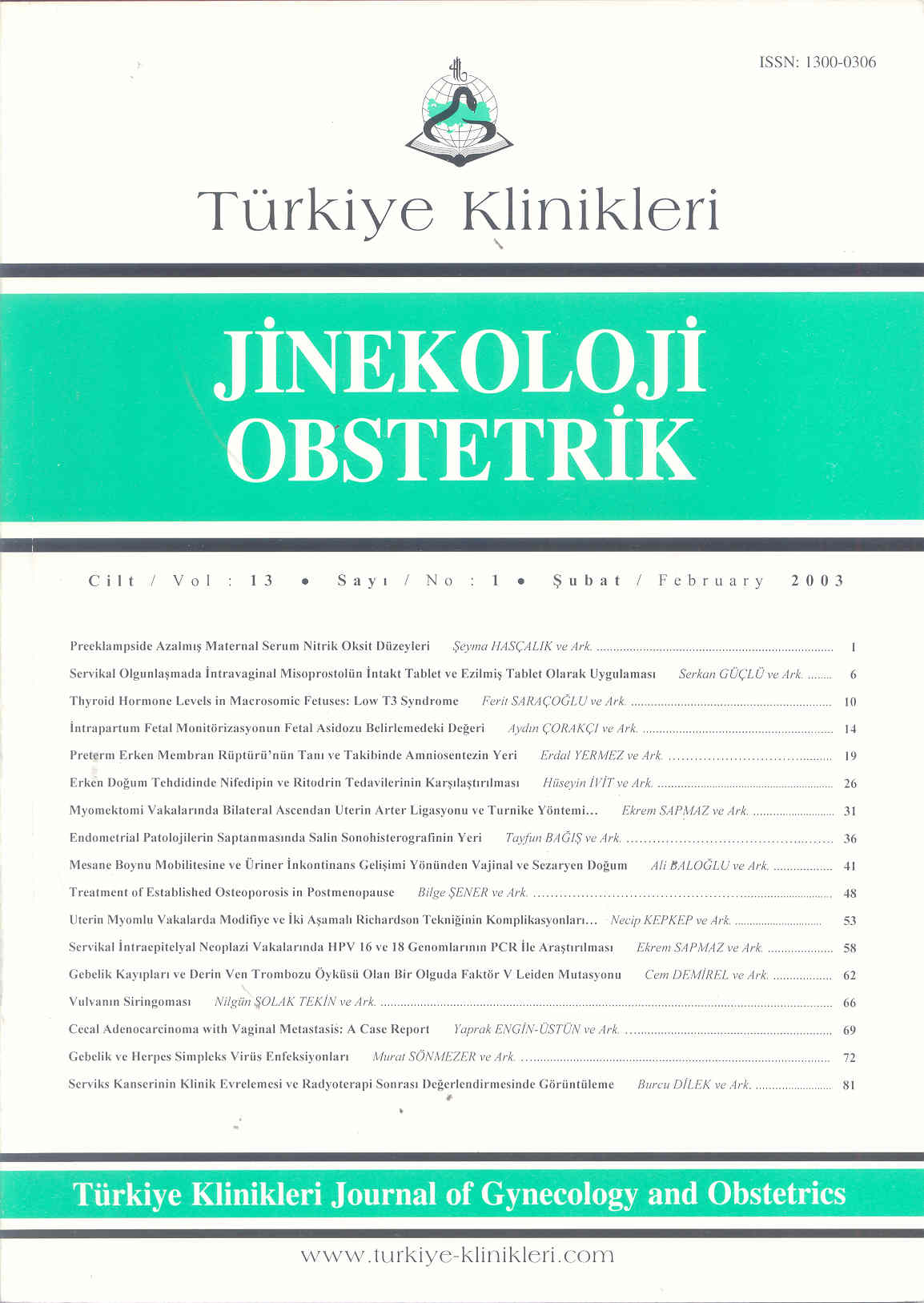Open Access
Peer Reviewed
ARTICLES
3178 Viewed1038 Downloaded
Thyroid Hormone Levels in Macrosomic Fetuses:Low T3 Syndrome
Makrozomi̇k Fetuslarda Ti̇roi̇d Hormon Düzeyleri̇: Düşük T3 Sendromu
Turkiye Klinikleri J Gynecol Obst. 2003;13(1):10-3
Article Language: TR
Copyright Ⓒ 2025 by Türkiye Klinikleri. This is an open access article under the CC BY-NC-ND license (http://creativecommons.org/licenses/by-nc-nd/4.0/)
ÖZET
Amaç: Fetal makrozominin gelişmesinde tiroid fonksiyonlarının değerlendirilmesi. Materyal ve Metod: Toplam 40 adet makrozomik fetus ve 18 adet normal doğum ağırlıklı fetus çalışmaya alınmıştır. Ha iki gruptaki fetusların kordon kanlarından total T3, total T4, serbet T3, serbest T4 ve TSH düzeyleri bakılarak karşılaştırılmıştırSonuçlar: Makrozomik fetuslarda; total T3 (0.33+0.17 ng/ml vs. 0.43+0.12 ng/ml), total T4 (9.37+3.88 micg/ml vs. 11.62+2.67 micg/ml) ve serbest T3 (0.99+0.48 pg/ml vs. 2.57+1.37 pg/ml) daha düşük bulunmuşken; TSH ve serbest T4 düzeyleri açısından 2 grup arasında herhangi bir fark saptanmamıştır. Yorum: Bu çalışmada makrozomik fetuslarda T3 düzeyinin oldukça düşük olduğunu saptadık. Bu durumdan sadece plasentanın değil fetusun kendisinin de sorumlu olabileceği akla gelmektedir.
Amaç: Fetal makrozominin gelişmesinde tiroid fonksiyonlarının değerlendirilmesi. Materyal ve Metod: Toplam 40 adet makrozomik fetus ve 18 adet normal doğum ağırlıklı fetus çalışmaya alınmıştır. Ha iki gruptaki fetusların kordon kanlarından total T3, total T4, serbet T3, serbest T4 ve TSH düzeyleri bakılarak karşılaştırılmıştırSonuçlar: Makrozomik fetuslarda; total T3 (0.33+0.17 ng/ml vs. 0.43+0.12 ng/ml), total T4 (9.37+3.88 micg/ml vs. 11.62+2.67 micg/ml) ve serbest T3 (0.99+0.48 pg/ml vs. 2.57+1.37 pg/ml) daha düşük bulunmuşken; TSH ve serbest T4 düzeyleri açısından 2 grup arasında herhangi bir fark saptanmamıştır. Yorum: Bu çalışmada makrozomik fetuslarda T3 düzeyinin oldukça düşük olduğunu saptadık. Bu durumdan sadece plasentanın değil fetusun kendisinin de sorumlu olabileceği akla gelmektedir.
ANAHTAR KELİMELER: Makrozomik fetus, Tiroid hormonları, Düşük T3 Sendromu
ABSTRACT
Objective: The present study was undertaken to examine the role of thyroid functions at term in the development of fetal macrosomia.Materials and Methods: This study compared the cord blood total T3, total T4, free T3, free T4 and TSH levels in macrosomic fetuses (n=40) at term with those of normal birth weight (n=18) .Results: The total T3 (0.33+/- 0.17 ng/ml versus 0.43+/- 0.12 ng/ml), total T4 (9.37+/-3.88 micg/ml versus 11.62 +/- 2.67 micg/ml) and free T3 (0.99 +/- 0.48 pg/ml versus 2.57 +/- 1.37 pg/ml) were found to be lower in the macrosomic group; whereas there was no statistical difference in TSH and free T4 values between the two groups. Conclusion: Laboratory findings resembling the low T3 Syndrome have been formed in macrosomic fetuses. It may be suggested that not only placenta but also the fetus itself may have a possible role in that situation.
Objective: The present study was undertaken to examine the role of thyroid functions at term in the development of fetal macrosomia.Materials and Methods: This study compared the cord blood total T3, total T4, free T3, free T4 and TSH levels in macrosomic fetuses (n=40) at term with those of normal birth weight (n=18) .Results: The total T3 (0.33+/- 0.17 ng/ml versus 0.43+/- 0.12 ng/ml), total T4 (9.37+/-3.88 micg/ml versus 11.62 +/- 2.67 micg/ml) and free T3 (0.99 +/- 0.48 pg/ml versus 2.57 +/- 1.37 pg/ml) were found to be lower in the macrosomic group; whereas there was no statistical difference in TSH and free T4 values between the two groups. Conclusion: Laboratory findings resembling the low T3 Syndrome have been formed in macrosomic fetuses. It may be suggested that not only placenta but also the fetus itself may have a possible role in that situation.
MENU
POPULAR ARTICLES
MOST DOWNLOADED ARTICLES





This journal is licensed under a Creative Commons Attribution-NonCommercial-NoDerivatives 4.0 International License.










